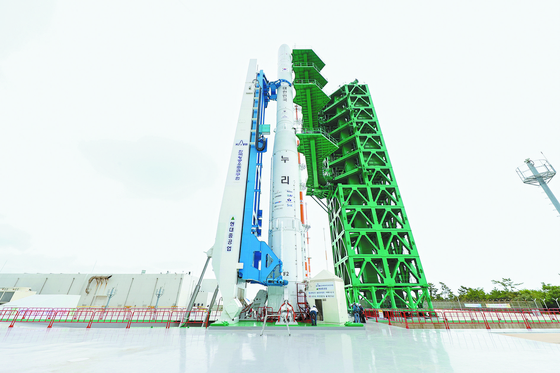Space industry is key to future development

The author is a professor emeritus of political and international affairs at Hanyang University.
Mitsubishi Heavy Industries leads Japan’s space industry. On several occasions, I visited its factory in Nagoya where the company produces H-2A rockets, Japan’s primary large launch vehicle. The “H” stands for hydrogen — more specifically, liquid hydrogen — used as rocket fuel. As liquid hydrogen requires a high level of technological expertise — for instance, it can explode at any time if mishandled — it has been used by advanced space powers. But Korea utilizes kerosene-based carrier rockets, which have been employed by Russia and SpaceX in the United States (Even if you use kerosene for rocket fuel, it does not affect propulsion power).
During my trip to the rocket plant, I asked Shoichiro Asada, head of the rocket department, how the state-led space industry was handed over to a private company like Mitsubishi Heavy Industries. As space development requires a huge amount of money in the initial stages, most of the jobs are carried out by governments. Despite frequent failures in the process, space powers have been able to build the foundation for space technology with uninterrupted financial inputs from the state. Once rocket technology reaches satisfactory levels, space development can be transferred to the private sector to help advance it further for profit.
Before entrusting Mitsubishi Heavy Industries with space development, the Japanese government required the company to launch at least three rockets per year — two of the launches on orders from Tokyo and the remaining one after making contracts with nations to launch their satellites in return for money. That’s exactly how Korea’s Arirang 3 satellite could be launched on a Japanese carrier rocket at the cost of 12 billion won ($9.34 million), cheaper than Russian rockets, to put the satellite into low earth orbit in 2012. That was the first case in which Japan launched a foreign satellite for profit. Much of the expenditure for our rocket launches has been paid to Japan.

As Japan has its own carrier rockets, it can launch meteorological satellites, military reconnaissance satellites, GPS satellites or remote sensing satellites whenever it wants. Japan does not have massive bills for rocket launches as Korea does (Korea paid France-based Arianespace over 70 billion won just for putting a weather satellite into an orbit with an Ariane rocket). That’s the sad reality for a country without its own rockets. It is time to accelerate the development of the space industry.
The space industry has grown in three stages over the past six decades. The first took place during the Cold War amid a heated contest for space development between the United States and the Soviet Union after the Soviets successfully launched Sputnik 1, the first artificial satellite to orbit earth, in 1957. The second phase of space development came with the diversification of space development after the Apollo 11 moon landing in 1969. The third stage took place after satellites for broadcast, communications, meteorology and navigation emerged as indispensable tools for daily lives and as key infrastructure. With the participation of private companies in space development, its commercialization will gain momentum. As a result, countries will fiercely compete to take economic gains and protect national interest through space exploration.
New growth engine for advanced countries
The global space industry is growing fast. The size of the market increased to $447 billion in 2020, up 4.4 percent from the previous year. Given the size of global semiconductor market, at $439 billion that year, the space industry has enormous impact on the national economy, suggesting humongous growth potential down the road.
Each government is pushing space development as a key part of investment for national growth. Following the U.S. lead in supporting the space industry to protect its future national interest, China, Japan, Britain and Australia have all expanded their space-related budgets to advance their space technology.
Most promising areas for the space industry are various big data services through a diverse range of satellites and the launching business for ultra-mini satellites. Starting as start-ups, SpaceX and Blue Origin have become global space enterprises leading the market. The total market capitalization of space companies already exceeds $4 trillion and will reach $10 trillion by 2030.
As space development has a broad impact on all industries, broadcast and communication businesses via satellite can trigger the development of TVs, mobile phones, chips, satellite reception devices and GPS receivers.
90 percent are small companies in Korea
In Korea, more companies are joining the space industry. Hanwha Aerospace took part in assembling the engine for the Nuri rocket, produced turbo pumps, a core part of the engine, and made engine-test equipment, while Hyundai Heavy Industries built the second launch pad for the rocket based on its earlier cooperation with Russia. Hyundai Rotem set up testing equipment for propulsion units, and Hankuk Fiber made the cover for the satellite.
Korea Aerospace Industries (KAI), a government-funded aerospace and defense company, conducted the overall assembly of the three-stage Nuri rocket. KAI has taken the lead in developing next-generation, mid-sized satellites to advance the development of the space industry in Korea. The making of small satellites was led by Satrec Initiative. After Hanwha Aerospace acquired it, the field of small-size satellites became bright. Still, the space industry is mostly led by small companies in Korea.
Compared to the great space powers, Korea has a long way to go in the organizational and financial aspects of the space business. The size of Korea’s space industry, at 3.26 trillion won as of 2020, accounts for 1 percent of the global space industry. Because its market structure is very vulnerable, as seen in the focus on R&D, the sector is not that competitive. Currently, 359 companies are involved in space development, and small- and mid-sized firms take the lion’s share (89.4 percent). Their annual sales average less than 1 billion won each.
Domestically-produced GPS is key
To develop the space industry, two conditions should be met. First, we must develop domestically-made rockets that can put a 3-ton satellite into 36,000-kilometer stationary orbit. If that is done, we can create a space industry habitat in which we can launch satellites for profit.
While maintaining state-led space development for a while, the government must give private companies confidence so they can rake in profits in the future through a government roadmap to develop space. The private sector also must hurry to invest, including in developing human resources. For Korea to succeed in space development, the government must create an environment for the private sector to lead the field — faster than its advanced counterparts did.
Second, the government must bring the completion date of the Korea Positioning System (KPS) to 2030 from the original 2035 to build national infrastructure for the fourth industrial revolution, including defense, self-driving cars and drones. The size of local industry related to satellite navigation systems is expected to grow to 50 trillion won, with the market in Asia-Pacific reaching about 400 trillion won.
Third, Korea must build a low-orbit — and ultrafast — satellite internet capable of 6G telecommunication by launching over 2,000 small satellites. Morgan Stanley anticipates the global space industry to grow to $1.1 trillion by 2040. The satellite internet market is expected to take up over 50 percent of the total.
Without a leader’s dream and ambition, developing the space industry is impossible. President Yoon Suk-yeol must pay special attention to the area to pave the way for our future generations.
Translation by the Korea JoongAng Daily staff.










with the Korea JoongAng Daily
To write comments, please log in to one of the accounts.
Standards Board Policy (0/250자)